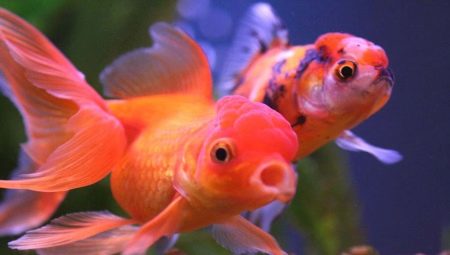The life of a modern person is filled with a huge amount of trouble, fuss, problems and stresses, which move him farther and farther from nature. In order to restore the emotional and psychological state after a working week, it is not necessary to go dozens of kilometers out of town, or you can create a living corner at home, the main element of which will be an aquarium. Aquarium and home ponds are unique designs that allow you to enjoy the inhabitants of the water depths without leaving your home.
In order to correctly fill a glass container, you need to seek help from professional aquarists, and all the required products can be purchased in specialized stores that also sell algae and a wide range of fish. The beauty and harmony of the aquarium depends on the chosen water inhabitants. Among a large number of fish species, experts recommend turning to one of the most beautiful - oranda.
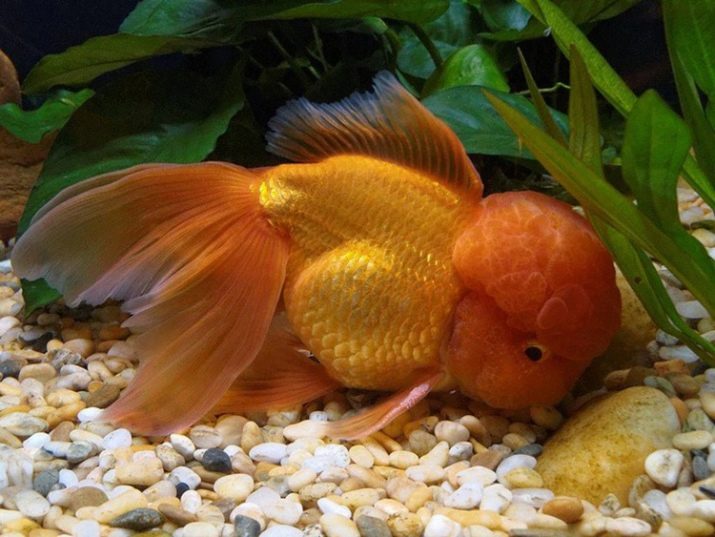
Description
Oranda is a very attractive species of aquarium goldfish from the carp family, which have bright fat growths on their heads. The homeland of the oranda is Japan. Back in the 15th century, the inhabitants of this country could enjoy the beauty of these fish. It was the Japanese who set the standard according to which the most valuable individuals should have the maximum number of bright formations on their heads. Such individuals should also have a tail in the form of a veil.
The average body length of the oranda is 19 cm, and the color has a wide color palette. Hong Kong breeders managed to grow fish, the size of which was 40 cm. This case is single and very rare. Fishes also show the presence of an unpaired dorsal fin and a long tail extremity, the size of which can be 70% of the total body length. All fins have a transparent structure and an elongated shape. Males differ from females in their small size and the appearance of white spots during the spawning period.
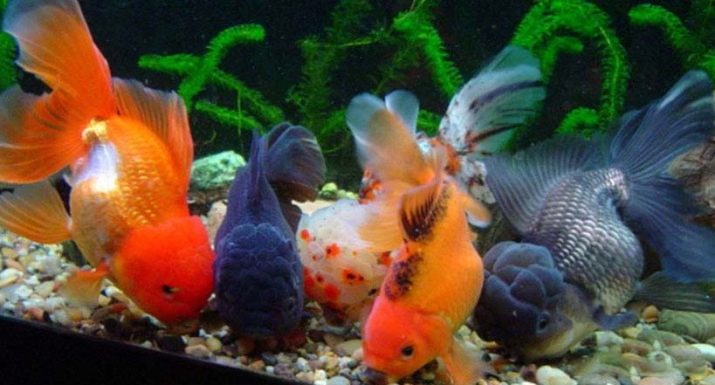
For a comfortable stay, the volume of the storage tank should not be less than 100 liters. Experienced aquarists recommend acquiring this species in pairs. In addition, fish have additional features that are considered disadvantages in the aquarium industry:
- non-bifurcated caudal fin;
- poorly developed fin on the back;
- asymmetric top view.
In comfortable living conditions, the oranda will be able to please its owners for up to 30 years. This elegant and unpretentious fish has a very shy character and does not tolerate the proximity to aggressive species.
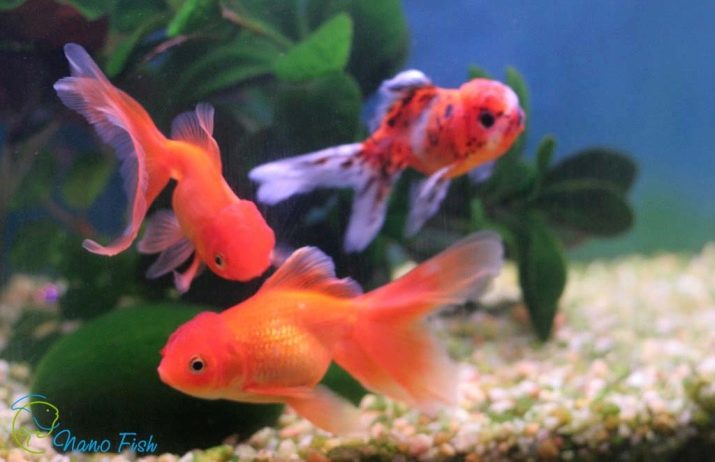
Varieties
This type of aquarium fish has several color shades and varieties. The most popular colors of oranda:
- saturated scarlet;
- gold;
- Orange;
- white;
- brown;
- the black;
- purple;
- motley;
- yellow.
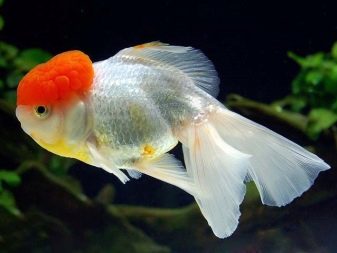
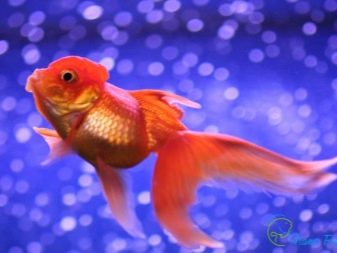
Novice aquarists should pay attention to the following varieties of oranda.
- Pompom (gyroshima). A beautiful subspecies that has furry growths on each side of the mouth. The size of these formations can reach up to 1 cm. A distinctive feature of this species is the presence of blue, red or white pompom on the tip of the nose. The rounded body of the fish can be up to 20 cm long. There is no fin on the low back, and the caudal and anal fins are divided into two parts.
- Red and white. This is a bright view of the oranda. The body of the fish is covered with mixed red and white spots.
- Chocolate The Chinese variety, in which the main color shade becomes brown, and the ebb of scales is silver. The length of the body can reach 25 cm. The color of the back and dorsal fin is always more saturated and dark, and the surface of the head is painted in a dark chocolate shade. Short fins have a rounded shape. This species refers to slowly floating.
- Blue This oranda has a matte body tint and blue spots in the back. Newborn specimens retain all breeding and parental characteristics.
- Gray. It is a dark gray species that has silver scales and a dark head and fins. The surface of the head is covered with formations in the form of warts. Long fins have rounded ends.
- Printed cotton. One of the oldest subspecies, which was obtained as a result of the combination of an oranda and a colorful telescope. The species received massive popularity only in the last few decades. Aquarists recommend growing chintz in large domestic ponds and spacious aquariums. The body length of the fish does not exceed 20 cm.
- Red Dutch (Lionhead). This is a fish that has a round and swollen body. The surface of the head is dotted with neat red formations that resemble the mane of a lion. The caudal fin is small in size and bifurcated. This subspecies does not have a dorsal fin. A distinctive feature is the presence of bright red-lemon scales, the edges of which have a red border. The hue of the fins and tail is red.
- "Red Riding Hood". A white fish that has on its head a large number of red growths resembling a hat. Due to this feature and the combination of white and red, the aquatic animal has a spectacular and elegant appearance, as well as a body resembling an egg. The body length reaches 25 cm. A large fin is located on the back. Tail and anal limbs are distinguished by a long bifurcated form.
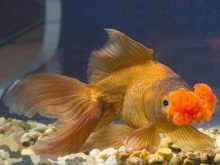
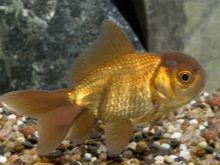
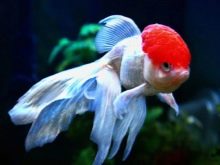
Despite the color variety, all species of this breed always have a contrasting growth on the head.If the conditions of detention are not observed, such a feature may disappear irrevocably.
Compatibility
To create a comfortable living environment oranda is not enough to properly design an aquarium. It is also necessary to carefully and carefully select her neighbors. A beautiful, graceful, elegant and non-conflict aquatic animal often becomes a victim of aggression from other residents of the reservoir, who not only offend him, but also bite beautiful fins.
Most unwanted neighbors:
- gurus
- barbs
- swordsmen;
- molliesia;
- cichlids;
- cockerels.
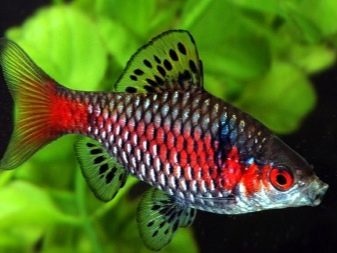
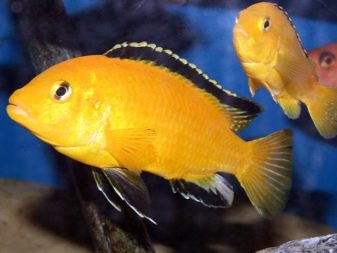
The following fish species can become comfortable neighbors:
- ancistrus;
- pterigoplicht;
- speckled catfish;
- all kinds of sanitary fish.
When selecting inhabitants for one aquarium, it is important to consider the needs of all its inhabitants, as well as their lifestyle, diet and temperament. Only in this case, the fish will not interfere with each other and violate personal space.

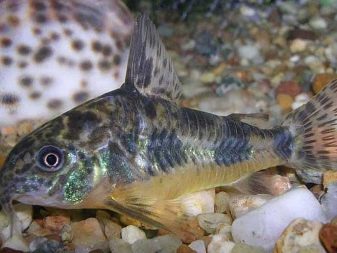
Growing conditions
To maintain a beautiful appearance and activity, experts recommend placing the oranda only in large containers with cold water, the volume of which will be sufficient for free movement. Thanks to its love of cool water, this species can be settled even in outdoor decorative ponds. To prevent the death of aquatic inhabitants and the appearance of various diseases in them, experts recommend regularly changing and filtering the water.
Consider the basic rules of care and maintenance of the oranda, which will maximize the life of pets and get healthy offspring:
- mandatory installation of a filtration system that will allow you to effectively purify water;
- constant saturation of water with oxygen;
- weekly renewal of at least 35% of water;
- the presence of run-in soil or river sand;
- compliance with the temperature level in the range from +18 to +22 degrees;
- maintaining acidity at level 8;
- the presence of bright lighting;
- keeping the stiffness level at a mark of no more than 16.

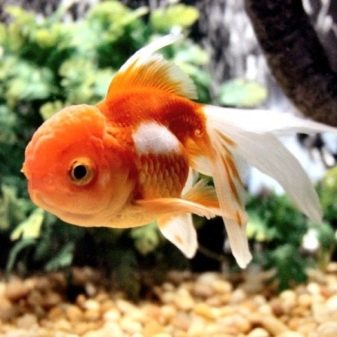
In favorable living conditions, bright growths show a tendency to constant growth, which can provoke blindness. Experts recommend cutting off excess body fat. This procedure will not cause problems for the fish and greatly facilitate its life.
To design a home reservoir, you can use the following elements:
- loose soil;
- fine gravel;
- driftwood;
- algae (live and artificial);
- moss.
Experts categorically prohibit the use of sharp interior items that can provoke the appearance of tears on the body of veil fish.
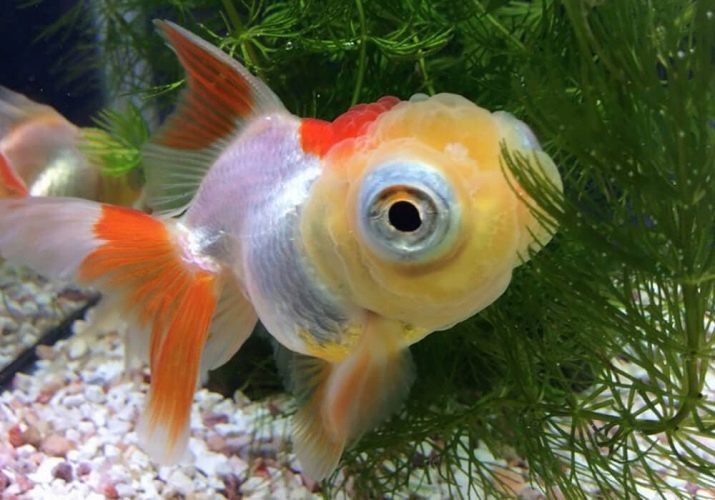
In order for the fish to swim freely, aquarists do not recommend planting a pond with a large number of plants. Algae should serve only for a minimum aesthetic design of the reservoir. When selecting plants, preference should be given to artificial algae or algae with hard and dense leaves that will not be damaged and eaten by fish. The following species can be attributed to this group of living plants:
- elodea;
- Wallisneria
- sagittaria;
- cabomba.
The root system of all planted algae must be securely fixed using soil and large stones.
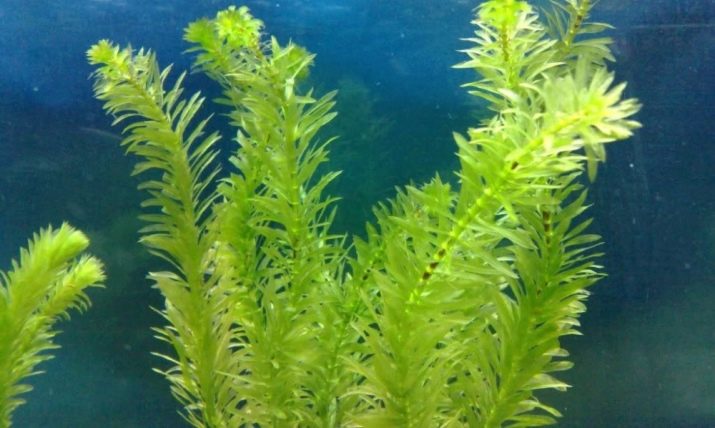
Failure to comply with the rules of growing and caring for fish can trigger the appearance of the following pathologies:
- decay of fins - in case of non-compliance with water parameters;
- the appearance of ichthyophthyroidism - low temperature water and the presence of a large number of individuals in one tank;
- poisoning (disruption of the digestive system) - poor aeration and poor care of the pond;
- bladder disease - unbalanced diet.
Feeding rules
The diet of this species can consist of both dry and live food. Oranda has a good appetite and is able to chew constantly. Experts do not recommend overfeeding pets, and when calculating the volume of the feed mixture, you will have to take into account the total weight of all fish. The amount of feed should be at 3% of the weight of the fish. Using more food can provoke not only obesity and fish diseases, but also their death. The main signs of eating excessive amounts of food are moving fish on their sides.
The diet of fry should consist of two meals a day, but adults should not throw food more than once a day. When the first signs of overfeeding appear, it is necessary to immediately limit the amount and number of feedings, and sometimes even put the pets on a diet.
Pet's favorite vegetable treats are salad leaves, spinach and various vegetable slices. Bloodworms, tubifex, daphnia and fresh or frozen worms will become live food for fish. To maintain the vitamin and mineral balance, experts recommend the use of special nutritional complexes for goldfish.
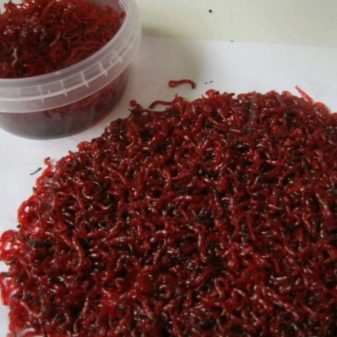
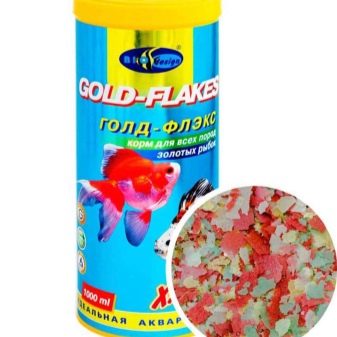
Breeding
Puberty of males and females occurs at the age of 12 months, but professional aquarists recommend mating fish at the age of 2 years. The most favorable time for mating is spring. For two females and one male, it is enough to install in the center of the pond a spawning ground with two sprayers, planted with small aquatic plants. The temperature of the water in the pond should not be lower than 24 degrees. Before mating, the female and male are in different containers for about 14 days, and animal feed must necessarily prevail in their diet.
In the most comfortable conditions, one fish is capable of producing up to 10 thousand eggs. To obtain healthy offspring, owners should independently remove pale muddy eggs from the nest. After 48 hours, the larvae begin to emerge, and after a week you can see swimming fry that pass the natural selection path. This method provides for the survival of only the strongest and most healthy fry.
The diet of newborn fish should consist of rotifers and live dust. Small pets have yellow growths and a low growth rate. To provoke reddening of growths, it is necessary to feed young fish with special pigmented food and make color injections.
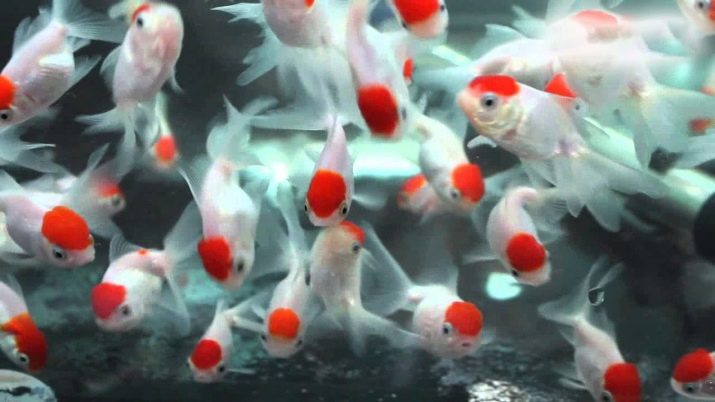
In order to start the process of breeding this type of fish, you need to purchase a certain number of individuals. For a purchase, it is better to go to specialized stores or to professional breeders. Experts do not recommend purchasing fish in natural markets, where they often sell sick underwater inhabitants. Also, beginner aquarists should pay attention to the appearance of sellers and living conditions.
Any pet is not only a source of a huge amount of positive emotions and positive, but also an object of constant care and attention. Many residents of large cities are unable to get cats and dogs because of the need to devote a lot of attention and time to them, therefore they prefer plants and fish, thinking that caring for the aquarium will not require a lot of time and will not cause difficulties. This opinion is erroneous and not true.
Before starting the arrangement of a home reservoir, it is necessary to carefully study all the details of caring for it so that such an acquisition does not become a burden and an unnecessary purchase.
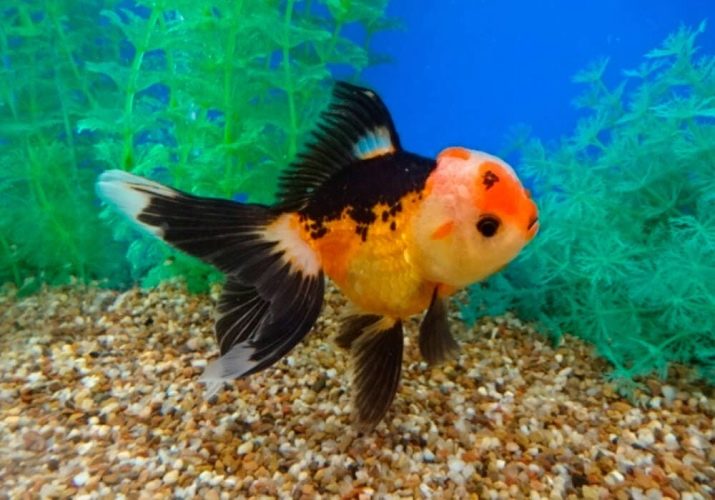
For more information about the features of these fish, see the next video.
